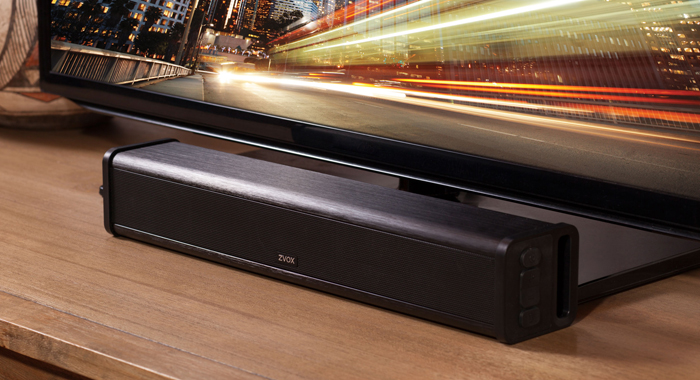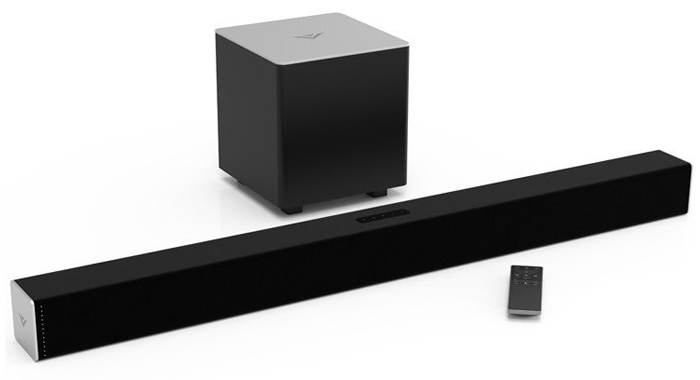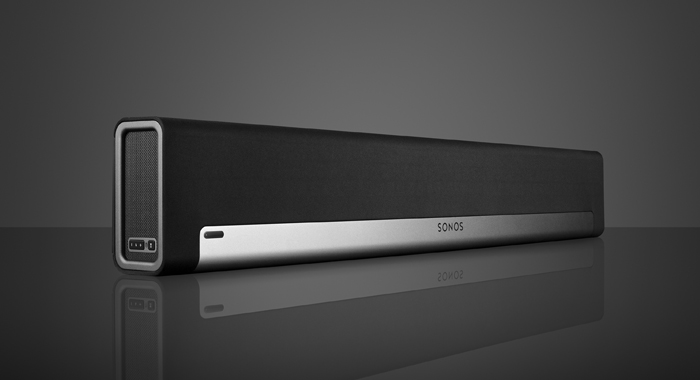
ZVOX AccuVoice
Head to your cupboard and grab the largest mug you own. Now take your smartphone and play some music from the phone’s speakers — then take the phone and place it into the mug. What happens? In most cases, that sound is amplified.
Now, look at your television — the part where the speakers are located, if you can find them. Pretty darn narrow, isn’t it? Your mug was probably deeper. This little experiment is a rudimentary example of a problem with your TV that you may not even know you had: the sound it puts out, to use a technical term, sucks.
One of the biggest complaints I’ve heard, beyond the lackluster bass response to onscreen explosions, is that dialogue is often hard to hear. There’s a reason for that — a few, actually. In the last decade, TVs have become increasingly thin, which is great for space and weight, but actually pretty bad for sound. Not only have the speakers in modern TVs gotten smaller, but due to size and the race for ever-decreasing bezels, there may be fewer speaker components inside your TV as well. This all makes for an audio experience that falls short of the visual experience that newer TVs provide. No bueno.
So, what’s the solution to the problem? In a word: soundbar. This little wonder is the plug-and-play solution audio equipment manufacturers like Sonos, Vizio, Yamaha, ZVOX, and others have brought to market. With a quality soundbar, you’re going to get great sonics and some compelling audio trickery which may keep you from feeling the need to purchase a full 5.1 surround sound system. You can pick up a soundbar for as little as $120 or invest in a luxury model as expensive as $1,800. What’s the difference between the equipment at either end of the spectrum? I had manufacturers ZVOX and Sonos send me review samples of entry-level and premium products to see what the current market has to offer. (In the coming weeks, I’ll also be looking at Sonos’ and Vizio’s 5.1 surround offerings for those of you who want to go full 5.1 but were looking for a primer, so stay tuned for that.)

Vizio SB3821
Jumping into the shallow end, we see that Vizio’s SB3821, which is a 2.1 system — meaning that you get the soundbar and a subwoofer — can be had for around $160, and most reviews of the product are exceedingly positive. It has dual digital inputs, RCA and AUX cable analog inputs, and Bluetooth wireless, which should more than meet most people’s needs. A step up from Vizio’s price is an offering from ZVOX. While many of the entry-level products you’ll find online and in your brick-and-mortar stores also come with subwoofers, the AccuVoice TV speaker from ZVOX doesn’t. I was looking forward to testing this one because it touts something that others don’t have: its purpose is to provide clear dialogue with a feature ZVOX calls “AccuVoice,” based on hearing aid technology. Though diminutive compared to the other product I tested (it weighs three pounds and comes in around a foot and a half long), the AccuVoice TV speaker truly lives up to its promise. I ran movies through it with epic battle or music-driven fight scenes where I’ve often found dialogue getting lost here and there — specifically Saving Private Ryan and Blade II, along with a few streaming episodics like Luke Cage, Atlanta, Insecure, and Agents of S.H.I.E.L.D. At no point was the dialogue in any show I watched lost or even the tiniest bit of a struggle to hear. The only area where the AccuVoice seemed to struggle was with high-pitched sound with the volume cranked up.
For its size, the AccuVoice definitely brings it, and I can objectively say that you will be getting a markedly better experience out of the AccuVoice than you’re currently getting from those speakers in your TV. When watching Luke Cage with my wife in the room, I’d turn down the soundbar and turn the TV back up; my wife immediately commented on the difference. It isn’t subtle at all. Due to its size, I wouldn’t say the AccuVoice is ideal for a large living room. If you’re in an average size apartment or condo, it’ll work just fine. If you’re looking for something for a large family room or home theater/man cave, keep reading.
Now what’s the difference between this and the products from Vizio in this price range? Connectivity. Vizio’s products also feature Bluetooth so you can stream music from a phone or tablet to the speaker, but that isn’t such a big deal. While these speakers are outstanding for television viewing, they’re definitely not as capable for everyday music. So, if your budget this holiday season is tight, but you want to get into a better sound experience for your media viewing, look for Black Friday and Christmas deals on Vizio and ZVOX. For under $300 you’re going to enhance your media viewing and make that downtime all the more enjoyable.
One thing I tend to look for in my gadget purchases is utility. Just how much use can I get out of my purchase for my money? The makers of Sonos products would say, “A lot.” Arguably at the top of the heap in their category, Sonos speaker systems allow you to build your ideal system one component at a time if your budget doesn’t allow for a full, multi-room system purchase up front. Sonos was one of the first to market with WiFi multi-room systems, but there is now stiff competition from Bose, Samsung, Polk, and others, and you can find multi-room setups cheaper than what Sonos charges. That being said, the sound, ease-of-use, and utility from Sonos’ mature product is well worth the cost. At $700, Sonos’ PLAYBAR, the only soundbar they make, filled my room with wondrous sound via some audio trickery which made me feel like I was listening to 5.1. The opening beachhead sequence in Saving Private Ryan is absolutely perfect for showcasing just how capable the PLAYBAR is. Streamed from Netflix, supporting 5.1, the virtual surround field the PLAYBAR creates is layered and effective, giving the sensation of being immersed in the sound the film’s editors painstakingly took the time to create. It does this through a nine-speaker driver design pushed by nine Class-D amplifiers. In other words, it’s pretty powerful. It’s larger than the ZVOX, on the other hand, so it’s going to require a bit more space on your TV table. Coming in at 11 pounds and almost three feet long, it feels substantial, like a product that’ll hold up for years to come — as high-quality speakers should.

Sonos PLAYBAR
The PLAYBAR is very easy to connect to your TV, but with one caveat: it doesn’t support analog connections, so no RCA or AUX cables will work if you’re using an older flatscreen TV that doesn’t have the required Optical Digital (TOSLINK) connection. Where Sonos systems shine is in the connectivity that is the backbone of the company: everything can be connected via WiFi or ethernet. WiFi connections are superior to Bluetooth connections because, theoretically, they offer better range and faster speeds. Using WiFi, all of your devices become “remote controls” for your Sonos system, and connecting multiple speakers is a cinch. You just download the Android or iOS app to your phone or tablet and you’re good to go. From my experience, you won’t really need it, but if you want it, expanding your PLAYBAR’s reach to include more boomy bass via the add-on SUB subwoofer, or two PLAY:1 rear-channel speakers for a true 5.1 surround system, is fairly simple. And, again, wireless. That’s a big deal because that means it’s easy to place those rear channel speakers and that subwoofer wherever you want for optimum sound or convenience.
I remember when I put together my first home theater-in-a-box system from Sony years ago and had to crawl up into the attic above the rec room because I wanted my rear channel speakers mounted to the ceiling, pointing downward. Now I can do it without the few minutes of vomiting I went through, having been face down in insulation, to get the job done. Just place the speakers and use the app to join them to the others in the group.
The other component that differentiates the Sonos and ZVOX offerings from many others is lack of HDMI connectivity. With Vizio and Yamaha systems, for instance, you can plug in other components via HDMI, so the soundbar acts as an input switcher. That expansion is definitely a nice option to have. With Sonos, all of your boxes (if you have a Chromecast, Roku, or gaming console) have to be connected to the TV itself. We can get into a debate about the differences between audio profiles supported over optical digital vs. HDMI, but that’s some inside baseball for the comments section, if you’re so inclined.
On the high end, you can go all the way up to a luxury $1,800 soundbar that will give you phenomenal sound quality. From what I’ve read, anyway — I have yet to test it. But at the $700 price point, the PLAYBAR handles music streamed from multiple sources, like Pandora and Spotify, just as well as it handles the sound from your TV. One thing all of these soundbars do equally well is equalize sound output — or in layman’s terms, keep those annoying commercials from BLASTING YOU WITH THEIR LOUDER-THAN-YOUR-SHOW AUDIO. Personally, that alone is worth the price of admission.
The great thing about an article like this is that while I hope you’ll take my word for it and heed my sage wisdom and recommendations, you can try this out for yourself. Simply walk into your nearest big box store and turn on one of the TVs on the floor that’s also connected to a soundbar. Listen to the TV by itself, then crank that soundbar up. Compare them. Hear the difference! Don’t worry, you don’t have to come back here and thank me — and f you’re already using a soundbar, sound off in the comments below and share your experiences.
Tshaka Armstrong is a huge nerd and activist who also writes for foxla.com and his own site, tshakaexplainsitall.com, where he talks about food, bearding properly, tech, family, and equality.
Follow Tshaka on Twitter: @tshakaarmstrong